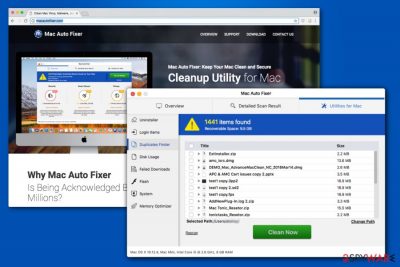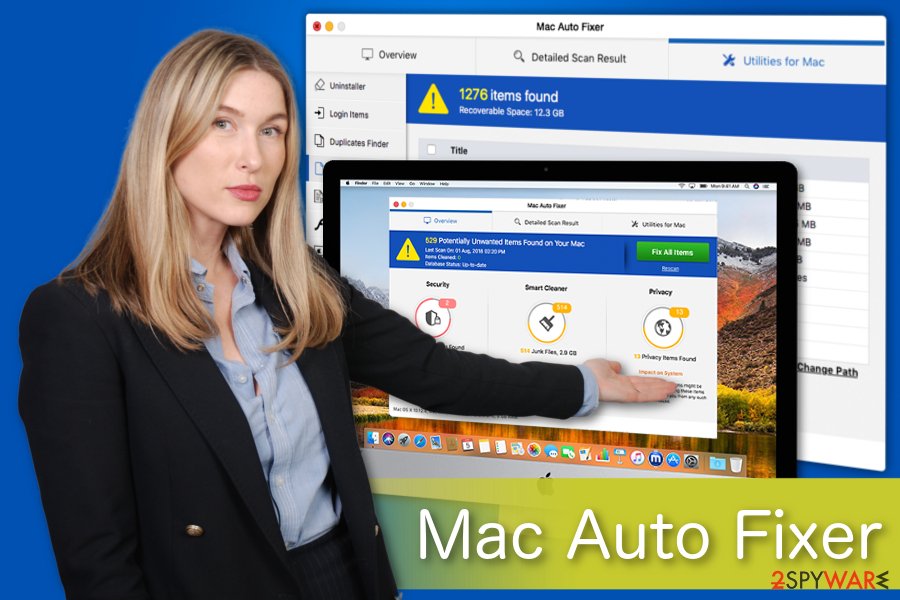Mac Auto Fixer (fake) - 2021 update
Mac Auto Fixer Removal Guide
What is Mac Auto Fixer?
Mac Auto Fixer is a potentially unwanted application which claims to fix Mac-related issues

Mac Auto Fixer is an unreliable system optimization tool that was developed by an infamous developer called PCVARK. The main sign showing that your PC is infected is the Maftask task that can be found running in the computer's Activity Monitor. This potentially unwanted program (PUP)[1] is similar to Advanced Mac Cleaner, Mac Tonic, Mac Mechanic, Mac Shiny, and similar suspicious applications that all promise to help users improve their PCs' functionality. However, if you have been wondering is this program a virus, we definitely recommend you to get rid of it. Despite its attractive description, GUI, and seemingly effective functionality, this program seems to imitate its activity on the system and seeks the only aim – your money. Don't buy its useless licensed version offered as the only way to improve the computer's work! There are plenty of free programs available on the market these days.
| Name | Mac Auto Fixer |
|---|---|
| Type | System tool; PUP; adware |
| Danger level | Medium. Does not perform system changes |
| related task | Maftask |
| Symptoms | Performs questionable system scans and reports about invented malware. Offers its paid license key as the only way to fix the system |
| main dangers | Spending your money on useless software; revealing your credit card information to strangers |
| Distribution | Third-party apps; bundling distribution technique |
| Elimination | You can uninstall potentially unwanted programs manually or clean the machine with anti-malware tools |
| Repair | Do not forget to restore affected or corrupted files. Find and fix such issues with FortectIntego |
Mac Auto Fixer virus has been bothering PC users for more than a year now.[2] Unreliable system optimization tools are not malicious apps that pose serious harm to PC systems. However, they rely on misleading distribution techniques, cause fake warning messages and then start pushing their victims into buying their license. In other terms, users are not advised to keep this program on their computers as it employs misleading techniques to sell its 118 € worth of license. Besides, it is not capable of fixing Mac-related problems.
Another issue related to its distribution techniques. Note that this app can be installed on the computers together with third-party tools or via fake ads offering to check the system for free. Likewise, many people do not even notice this potentially unwanted program until it starts delivering intrusive and less than reliable Mac Auto Fixer ads and scanners that include the list of invented errors.
Once inside the system, the app performs system scans that report numerous cyber threats and errors. The list of scan results includes the following:
- Infected files;
- Junk items;
- Privacy exposing data.
According to the experts, it is not hard to check the reliability of the unwanted items found by the questionable tool. You should install an alternative optimization tool, which is known to be reliable, and run a full system scan. You can also use your own anti-virus software. Once it finishes its scan, compare its results with the ones displayed by the PUP. We can guarantee that there will be no errors similar to the ones included in the first scan.
The scan results and cyber threats detected by this program are non-existent and merely shown just to trick gullible people into purchasing the full version of the program. Likewise, Mac Auto Fixer virus term is a popular description used by people online.

Furthermore, users who have Mac Auto Fixer are disappointed as it causes unwanted redirects to other questionable sites. Be aware that the developers of this software are not responsible for the content of those websites. Thus, users might end up on malware distribution pages and infect their Mac computers with threats similar to the potentially unwanted application.
It is evident that this fraudulent system optimization tool is not worth your trust. Likewise, the best decision would be to switch to a professional security tool and remove the app without dealing with the useless software. If you want to speed up your computer's functionality, get FortectIntego or another reliable software that is capable of doing that.
For Mac Auto Fixer removal, you can use manual removal guide presented below. In case your computer is also infected with Mac Mechanic or MacShiny, you will need to uninstall them as well. Before that, launch Activity Monitor to force quit the PUP. Thus, a full system scan is recommended after uninstalling these apps as it helps you make sure that all unwanted components are gone. To prevent the reappearance of this PUP, make sure you delete the intruder together with its leftover files.
Bundling: PUPs infiltrate the system without the user's consent
There are several distribution techniques used to spread potentially unwanted programs (PUPs). Although, the most prominent and widely used one remains bundling as it does not require the user's consent to infiltrate the system. This method allows the developers to offer their questionable tools as one program with another third-party app.
However, there is a way how users can detect and reject potentially unwanted programs during the installation of freeware. The first step is to never agree with Quick or Recommended settings. Instead, you MUST pick Advanced or Custom ones as this is the only way to reveal hidden PUPs.
Keep in mind that they come as optional components. Likewise, you should attentively check each installation step and search for pre-selected items. PUPs may be marked as “I agree to install XXX,” or “Get XXX now” check-marks. De-select them and double-check your system with an antivirus.
How to remove Mac Auto Fixer from the affected PC system
If you have been wondering how to get rid of the app from your operating system, note that you are dealing with a potentially unwanted program that can run numerous tasks in the system's background to stay active. According to PC security researchers,[3] you should check the Activity Monitor on your computer to disable the virus. For that:
- Open Utilities folder and locate the Activity Monitor;
- Here, find Mac Auto Fixer, click the mouse on it and click Quit Process;
- Select the Force Quit when a pop up asking if you would like to quit the executable shows up;
Once you perform these steps, you should proceed with the traditional method to uninstall the PUP. Note that potentially unwanted programs are sneaky cyber threats that can leave related elements after inappropriate elimination. Therefore, it is essential to remove the PUP with all its components from the system. Otherwise, the application might reappear after a while.
The best option to do after you take care of Mac Auto Fixer removal is to check the system with the help of a professional security tool. The antivirus will not only uninstall the leftover files PUP but will also get rid of other potentially unwanted programs that might be present on your system. For that, check the list of our recommendations below.
You may remove virus damage with a help of FortectIntego. SpyHunter 5Combo Cleaner and Malwarebytes are recommended to detect potentially unwanted programs and viruses with all their files and registry entries that are related to them.
Getting rid of Mac Auto Fixer. Follow these steps
Delete from macOS
Remove items from Applications folder:
- From the menu bar, select Go > Applications.
- In the Applications folder, look for all related entries.
- Click on the app and drag it to Trash (or right-click and pick Move to Trash)

To fully remove an unwanted app, you need to access Application Support, LaunchAgents, and LaunchDaemons folders and delete relevant files:
- Select Go > Go to Folder.
- Enter /Library/Application Support and click Go or press Enter.
- In the Application Support folder, look for any dubious entries and then delete them.
- Now enter /Library/LaunchAgents and /Library/LaunchDaemons folders the same way and terminate all the related .plist files.

Delete from Safari
Remove unwanted extensions from Safari:
- Click Safari > Preferences…
- In the new window, pick Extensions.
- Select the unwanted extension and select Uninstall.

Clear cookies and other website data from Safari:
- Click Safari > Clear History…
- From the drop-down menu under Clear, pick all history.
- Confirm with Clear History.

Reset Safari if the above-mentioned steps did not help you:
- Click Safari > Preferences…
- Go to Advanced tab.
- Tick the Show Develop menu in menu bar.
- From the menu bar, click Develop, and then select Empty Caches.

Remove from Google Chrome
Delete malicious extensions from Google Chrome:
- Open Google Chrome, click on the Menu (three vertical dots at the top-right corner) and select More tools > Extensions.
- In the newly opened window, you will see all the installed extensions. Uninstall all the suspicious plugins that might be related to the unwanted program by clicking Remove.

Clear cache and web data from Chrome:
- Click on Menu and pick Settings.
- Under Privacy and security, select Clear browsing data.
- Select Browsing history, Cookies and other site data, as well as Cached images and files.
- Click Clear data.

Change your homepage:
- Click menu and choose Settings.
- Look for a suspicious site in the On startup section.
- Click on Open a specific or set of pages and click on three dots to find the Remove option.
Reset Google Chrome:
If the previous methods did not help you, reset Google Chrome to eliminate all the unwanted components:
- Click on Menu and select Settings.
- In the Settings, scroll down and click Advanced.
- Scroll down and locate Reset and clean up section.
- Now click Restore settings to their original defaults.
- Confirm with Reset settings.

Remove from Microsoft Edge
Delete unwanted extensions from MS Edge:
- Select Menu (three horizontal dots at the top-right of the browser window) and pick Extensions.
- From the list, pick the extension and click on the Gear icon.
- Click on Uninstall at the bottom.

Clear cookies and other browser data:
- Click on the Menu (three horizontal dots at the top-right of the browser window) and select Privacy & security.
- Under Clear browsing data, pick Choose what to clear.
- Select everything (apart from passwords, although you might want to include Media licenses as well, if applicable) and click on Clear.

Restore new tab and homepage settings:
- Click the menu icon and choose Settings.
- Then find On startup section.
- Click Disable if you found any suspicious domain.
Reset MS Edge if the above steps did not work:
- Press on Ctrl + Shift + Esc to open Task Manager.
- Click on More details arrow at the bottom of the window.
- Select Details tab.
- Now scroll down and locate every entry with Microsoft Edge name in it. Right-click on each of them and select End Task to stop MS Edge from running.

If this solution failed to help you, you need to use an advanced Edge reset method. Note that you need to backup your data before proceeding.
- Find the following folder on your computer: C:\\Users\\%username%\\AppData\\Local\\Packages\\Microsoft.MicrosoftEdge_8wekyb3d8bbwe.
- Press Ctrl + A on your keyboard to select all folders.
- Right-click on them and pick Delete

- Now right-click on the Start button and pick Windows PowerShell (Admin).
- When the new window opens, copy and paste the following command, and then press Enter:
Get-AppXPackage -AllUsers -Name Microsoft.MicrosoftEdge | Foreach {Add-AppxPackage -DisableDevelopmentMode -Register “$($_.InstallLocation)\\AppXManifest.xml” -Verbose

Instructions for Chromium-based Edge
Delete extensions from MS Edge (Chromium):
- Open Edge and click select Settings > Extensions.
- Delete unwanted extensions by clicking Remove.

Clear cache and site data:
- Click on Menu and go to Settings.
- Select Privacy, search and services.
- Under Clear browsing data, pick Choose what to clear.
- Under Time range, pick All time.
- Select Clear now.

Reset Chromium-based MS Edge:
- Click on Menu and select Settings.
- On the left side, pick Reset settings.
- Select Restore settings to their default values.
- Confirm with Reset.

Remove from Mozilla Firefox (FF)
Remove dangerous extensions:
- Open Mozilla Firefox browser and click on the Menu (three horizontal lines at the top-right of the window).
- Select Add-ons.
- In here, select unwanted plugin and click Remove.

Reset the homepage:
- Click three horizontal lines at the top right corner to open the menu.
- Choose Options.
- Under Home options, enter your preferred site that will open every time you newly open the Mozilla Firefox.
Clear cookies and site data:
- Click Menu and pick Settings.
- Go to Privacy & Security section.
- Scroll down to locate Cookies and Site Data.
- Click on Clear Data…
- Select Cookies and Site Data, as well as Cached Web Content and press Clear.

Reset Mozilla Firefox
If clearing the browser as explained above did not help, reset Mozilla Firefox:
- Open Mozilla Firefox browser and click the Menu.
- Go to Help and then choose Troubleshooting Information.

- Under Give Firefox a tune up section, click on Refresh Firefox…
- Once the pop-up shows up, confirm the action by pressing on Refresh Firefox.

After uninstalling this potentially unwanted program (PUP) and fixing each of your web browsers, we recommend you to scan your PC system with a reputable anti-spyware. This will help you to get rid of Mac Auto Fixer registry traces and will also identify related parasites or possible malware infections on your computer. For that you can use our top-rated malware remover: FortectIntego, SpyHunter 5Combo Cleaner or Malwarebytes.
How to prevent from getting system tools
Access your website securely from any location
When you work on the domain, site, blog, or different project that requires constant management, content creation, or coding, you may need to connect to the server and content management service more often. The best solution for creating a tighter network could be a dedicated/fixed IP address.
If you make your IP address static and set to your device, you can connect to the CMS from any location and do not create any additional issues for the server or network manager that needs to monitor connections and activities. VPN software providers like Private Internet Access can help you with such settings and offer the option to control the online reputation and manage projects easily from any part of the world.
Recover files after data-affecting malware attacks
While much of the data can be accidentally deleted due to various reasons, malware is one of the main culprits that can cause loss of pictures, documents, videos, and other important files. More serious malware infections lead to significant data loss when your documents, system files, and images get encrypted. In particular, ransomware is is a type of malware that focuses on such functions, so your files become useless without an ability to access them.
Even though there is little to no possibility to recover after file-locking threats, some applications have features for data recovery in the system. In some cases, Data Recovery Pro can also help to recover at least some portion of your data after data-locking virus infection or general cyber infection.
- ^ Potentially unwanted program. Wikipedia, the free encyclopedia.
- ^ Permanently delete malware: Mac Auto Fixer (previously Mac Defender). Apple macOS High Sierra forum.
- ^ Virukset. Virukset. Security and Spyware News.




















